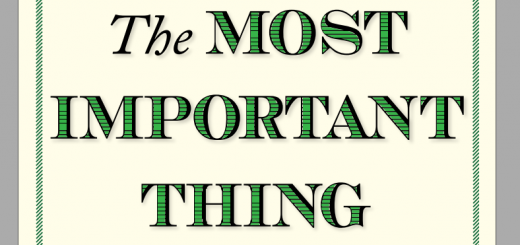The Most Important Thing Part 1 – 2nd level thinking, efficiency and value

Today’s post is our first visit to a new book – The Most Important Thing by Howard Marks.
Howard Marks
Howard Marks runs Oaktree Capital Management and is famous for the letters and memos he writes to his investors (in the same way that Warren Buffett is).
- This book is based on those memos, although they have been updated (to 2011, when the book was written) and edited for clarity.
The title of the book comes from a 2003 memo in which Marks described 18 things which he had described in client meetings as “the most important thing”.
- The book has 20 chapters, so Marks has added to the list since then.
Marks says:
This book is a statement of my investment philosophy. There’s no surefire recipe for investment success.
It’s not my goal to simplify the act of investing. In fact, the thing I most want to make clear is just how complex it is.
He adds:
One cannot develop an effective philosophy without having been exposed to life’s lessons. Experience is what you got when you didn’t get what you wanted.”
Good times teach only bad lessons: that investing is easy, that you know its secrets, and that you needn’t worry about risk. The most valuable lessons are learned in tough times.
Second-level thinking
The first chapter in the book is pretty simple – it says that to beat the market, you need to think unconventionally.
Investing is hard, for a number of reasons:
- no rule works all of the time
- the environment is constantly changing
- investor psychology is important and variable
- investment approaches change the environment, eventually leading to the need for a new approach
One of the things I most want to emphasize is how essential it is that one’s investment approach be intuitive and adaptive rather than be fixed and mechanistic.
Since investing is zero-sum, you need to be confident that you are in the top half of investors.
- Confidence is not a problem for most people when assessing their own abilities.
The definition of successful investing is] doing better than the market and other investors. To accomplish that, you need either good luck or superior insight.
Everybody wants to make money, and to beat the market.
- To beat all these other guys, you need what Marks calls second-level thinking.
First-level thinking says, “It’s a good company; let’s buy the stock.” Second-level thinking says, “It’s a good company, but everyone thinks it’s a great company, and it’s not. So the stock’s overrated and overpriced; let’s sell.”
The prevalence of first-level thinkers increases the returns available to second-level thinkers. To consistently achieve superior investment returns, you must be one of them.
You need to have a view of the range of possible outcomes (and their probabilities) that varies from the consensus.
- And you need to think that the consensus has led to a price that is too bullish or too bearish.
Marks warns that plenty of people will say that investing is simpler than that:
- “mercenaries” at brokerages and mutual fund companies who want you to trade, or to put your money with them
- “proselytizers” – academics and practitioners who overestimate their ability
- people who just don’t understand
Extraordinary performance comes only from correct non-consensus forecasts, but non-consensus forecasts are hard to make, hard to make correctly and hard to act on.
Market efficiency
Chapter two is about the efficient markets hypothesis (EMH) and its limitations.
The idea is that all market participants have access to the same information and work hard to incorporate into their valuation models.
- Which means that the market price is the correct one, given the information available.
- Riskier assets will, therefore, be priced to deliver higher returns (ie. will be cheaper) in order to attract buyers.
- All returns are related to (are compensation for) risk.
The implication is that it is impossible to beat the market.
- The often-quoted studies of active fund performance would seem to bear this out.
Outperformance by individual investors (such as Buffett) is attributed to luck and/or the “infinite monkey” theorem.
- You need decades of data to prove outperformance statistically, and most investors retire before the threshold is reached.
Marks also points out that the level of attention people like Buffett receive is a testament to how rare they are.
Marks believes that the consensus view is not always correct, and so prices are sometimes not correct.
- This seems obvious to me, simply by observing bubbles in the market.
Marks refers to the dot com boom when Yahoo went from $237 to $11 in fifteen months.
- It’s hard to believe that both prices were right.
Which is not the same as saying that mispricing is easy to identify and act on at the time.
But Mark’s greatest criticism of EMH concerns risk:
If riskier investments could be counted on to produce higher returns, they wouldn’t be riskier.
That’s a great quote, but I think it works by conflating two definitions of risk – it’s more of a joke based around a pun.
- You do need to take on more risk to get higher returns, but this is risk defined as volatility.
- Not taking on that kind of risk will lead to taking on the other kind of risk (permanent loss of capital, relative to inflation and/or a benchmark).
It is easy to beat the market (not by that much, but by enough) by getting exposure to the correct risk factors.
- And I do believe that the extra returns are compensation for taking on a risk (ie. volatility) that other people don’t want to bear.
The real irony is that if you take on enough risk factors, their imperfect correlations lead to the volatility of the portfolio becoming lower than it was to start with (in a single market).
- That’s the free lunch of diversification.
Marks disagrees:
Nothing – and certainly not the indiscriminate acceptance of risk – carries the promise of a free lunch.
I would, of course, argue that my risk-taking is anything but indiscriminate.
In any case, there are bigger issues:
- Most people’s (inadequate) returns will be determined by their (inadequate) exposure to (volatile) equities.
Diversifying across a wide range of risks will enable an investor to run a higher allocation to stocks, and so to receive a higher long-run return.
Marks believes that FX markets are efficient, and major stock markets are usually efficient.
- To beat them needs second-level thinking.
[The] first test is always the same: “And who doesn’t know that?”
The key weakness in the EMH is its assumption that people are objective – rational if you prefer.
Human beings are not clinical computing machines. Rather, most people are driven by greed, fear, envy and other emotions that render objectivity impossible and open the door for significant mistakes.
There’s also the idea that all investors are open to all asset classes, and can go long or short as required.
- This is far from the real picture.
Let others believe markets can never be beat[en]. Abstention on the part of those who won’t venture in creates opportunities for those who will.
However:
I concluded that because the notion of market efficiency has relevance, I should limit my efforts to relatively inefficient markets where hard work and skill would pay off best.
Value
Chapter three is about value investing.
An accurate estimate of value is the indispensable starting point.
If you know the intrinsic value of an asset, investing becomes easy:
Buy at a price below intrinsic value, and sell at a higher price.
Marks begins the chapter by dismissing technical analysis (of price information) and advising us to stick to fundamental investing.
He even takes the time to specifically dismiss momentum investing.
- His objection seems to be that momentum investors don’t have a suitable sell rule, and don’t short.
How will this approach help them sell in time to avoid a decline? And what will it have them do in falling markets?
He also quotes the (ultimately negative) experience of day traders in the dot com boom.
- My own experience was rather different.
Admittedly I was trading on daily data (I had a day job) but I successfully momentum traded lots of tech stocks that I knew little about.
- And I got out of the market in March 2000, when it started to crash.
I don’t think Marks has much practical experience of this subject, but I agree with him that day trading should be avoided by almost everyone.
Having dispensed with momentum, Marks divides investing into value investing and growth investing.
- Value investors are the buy low, sell high types who use intrinsic value.
The emphasis in value investing is on tangible factors like hard assets and cash flows. Intangibles like talent, popular fashions and long-term growth potential are given less weight.
On the other hand:
Growth investors try to find securities whose value will increase rapidly in the future.
Growth investing lies somewhere between the dull plodding of value investing and the adrenaline charge of momentum investing. Its goal is to identify companies with bright futures.
There’s less emphasis on the company’s current attributes and more on its potential.
Marks doesn’t see too much difference between the approaches:
The choice isn’t really between value and growth, but between value today and value tomorrow. The batting average for growth investors should be lower, but the payoff for doing it well might be higher.
There’s no bright-line distinction between value and growth; both require us to deal with the future. However, I think it can fairly be said that growth investing is about the future, whereas value investing emphasizes current-day considerations.
But, in the end:
Value is my approach. In my book, consistency trumps drama.
He even likes averaging down:
Value investors score their biggest gains when they buy an underpriced asset, average down unfailingly and have their analysis proved out.
Marks warns not to expect a stock you buy on the cheap to reward you immediately.
- There’s probably a reason why it’s cheap, and conditions may take some time to improve.
Being too far ahead of your time is indistinguishable from being wrong.
Psychology and bubbles
Chapter four explores the relationship between value and price.
- Marks emphasises the importance of buying at a good price
- And of avoiding being a forced seller (a leveraged investor who receives a margin call).
Then he gets on to psychology:
It’s impossible to overstate how important this is. The key to understanding the price/value relationship – and the outlook for it – lies largely in insight into other investors’ minds.
Investor psychology can cause a security to be priced just about anywhere in the short run, regardless of its fundamentals.
The key is who likes the investment now and who doesn’t. Future price changes will be determined by whether it comes to be liked by more people or fewer people in the future.
Investing is a popularity contest, and the most dangerous thing is to buy something at the peak of its popularity. At that point, all favourable facts and opinions are already factored into its price, and no new buyers are left to emerge.
The safest and most potentially profitable thing is to buy something when no one likes it. Its popularity, and thus its price, can only go one way: up.
After that he talks about bubbles, including Tulipomania, the dot-com boom and the US real estate bubble:
All bubbles start with some nugget of truth.
Things can be overpriced and stay that way for a long time – or become far more so.
A “top” in a stock, group or market occurs when the last hold-out who will become a buyer does so.
Conclusions
And that’s it for today.
I have to admit that I’m a little disappointed – this book has been recommended to me several times.
- But Marks seems to be a hard-core value investor, with little time for anything else.
I’m not against value, but I prefer a blend of approaches since none will work all of the time.
- And value has had a terrible decade recently.
Marks also seems to prefer intuition to the systematic approach that I am drawn to.
- And he doesn’t like momentum or even diversification.
But he does approve of averaging down.
On the other hand, it’s a nicely written book, and not a chore to work through.
We’re about a fifth of the way through, and I’ll be back in a few weeks with another four chapters.
- Up next are Risk and Cycles.
Until next time.















